Digger talks to Guy
Portelli, the sculptor who secured the support of three of the
Dragons on The Dragons' Den TV programme. Guy's Pop Icon sculptures
featuring luminaries such as Frank Sinatra, Miles Davis, John Lee
Hooker, John Lennon, Jimi Hendrix, The Who, Led Zeppelin, David
Bowie, Elton John, Sex Pistols, Sade, Grace Jones, The Spice Girls,
Bob Marley, Madonna, Tupac, Bono and Amy Winehouse have captured the
imaginations of the art world, investors and the public.
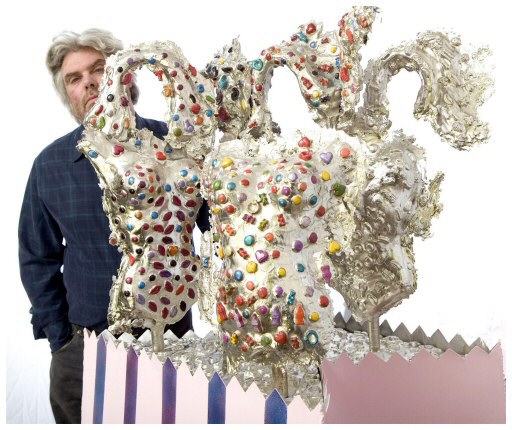
Guy with the Spice Girls
sculpture
About
Guy:
GUY
PORTELLI RBA, ARBS - Born . South Africa 13th June 1957
Studied Interior Design and 3D Design at Medway College of Art
1974-78
Worked as a sculptor in the special effects dept for the BBC TV
before setting up own studio in 1981, producing sculptures for
the advertising market. His first opportunity in the world of
fine art sculpture was being commissioned to sculpt 13, 9ft
classical sculptures for The London Pavilion, in Piccadilly
Circus, London.
Having gained a reputation for Classical sculpture, he wanted to
promote the more creative aspects of his work, and set about
exhibiting his abstract sculptures in galleries, sculpture
parks, Manchester Art House, Sausmarez Manor in Guernsey, and a
major London show with Andrew Logan. Many large commissions
followed.
Elected as a member of the Royal Society of British Sculptors in
1998 and voted on to the council in 2000. Actively involved with
the promotion of sculpture organising many group exhibitions.
In
2005 he authored ‘Modern British Sculpture’ a comprehensive
study of modern sculpture developments in Great Britain.
This is the
interview Guy gave to Digger at www.retrosellers.com
Pop Icon images © copyright Guy Portelli.
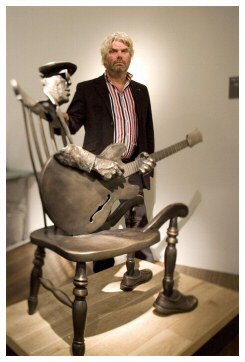
Guy with the John Lee Hooker
sculpture
Digger: Are you full-time in the studio or how does it work?
Guy: I
suppose the time is split three ways really. There's design and
research, which is always ongoing. Then there's the development of
ideas into production and then there's the marketing. So really it's
a way of life, it's not a job. Probably I'm doing 14 or 15 hours a
day, seven days a week.
Digger:
A lot of people wouldn't be able to relate to those kind of hours,
even though we're supposed to be the hardest working in Europe. It's
with you all the time, isn't it?
Guy: It
is, but we just delivered a sculpture to Ringo Starr the other day.
I sat in the lorry and we went down there and delivered it.
Digger:
Which one did he take?
Guy:
We've been making some large pieces for him which I've been working
with him to develop. These are nine feet tall sculptures.
Digger:
What a great job you've got!
Guy:
Yeah, I sit in a lorry, I go down there and we winch it off the
lorry and it weighs about half a ton. We have a cup of tea and we
chat to Barbara and Ringo and then we get back in the lorry and we
come home. Now to some people that's a day's work - if you're a
lorry driver. For me it's a social outing.
Digger:
(Laughs) I hope you've been to health and safety courses for lifting?
Guy: No
we had to hire a gadget on the back and I just stand and watch. There
are probably times when we're risking our lives but that wasn't one
of them.
Digger:
I understand that Ringo has got the collecting bug in the last few
years?
Guy:
There's a lot of sculptures around his garden and he does like
sculpture and he likes working with artists as well. I think he gets
a lot of pleasure with that and he was telling me last time that he
and Barbara had been on a painting class in the south of France.
They're proactive and they're not just people who sit around doing
nothing.
Digger:
I suppose originally, with the early Beatles, they were from an art
background and potentially going to be artists.
Guy: I
think Paul McCartney and John Lennon were art college students.
Ringo was a sheet metal worker - as he keeps telling me. He asked me a
trick question and said "How's that aluminium going to weather?" And I said "Oh no, it will be great." And
he said "You can't fool me, I used to be a sheet metal worker.
I know what's going to happen to it." He is right, but
fortunately he likes things to mature and develop. All the work we
do for him, he wants it to tarnish and patinate.
Digger:
It's like when you look out on a cityscape and you see all the green
roofs, it's nice to see that colouring.
Guy:
Yeah, that's right. There's one new panel in there and it's not
blending in with the rest of it. I'm enjoying my working
relationship with the pair of them and it's not in isolation because
Barbara is very proactive and has a very strong opinion on things so
it's a three-way thing. So one minute I'm here at the computer doing all
my emails, the next minute I'm outside sanding down.
Digger:
Do you ever rush in to the computer with your hands all dirty?
Guy:
Sometimes, I'm elbow-deep in plaster and the 'phone rings and I need
to answer it. I have lines of shoes at the bottom of the stairs,
ones that I can slip on and off 'cos I'm running off to the workshop
and then I'm running back and I don't like to run clay and plaster
all through the house. My shoes are on and off ten times a day. So I
never wear socks because socks are a hindrance. It would be alien to
most people.
Digger:
It sounds as though you have to be disciplined in your allocation of
time. And a lot of artists would be accused of not being able to be
good marketers or good business people, but clearly you've got a
knack for it.
Guy: I
enjoy communication. I remember when I was young listening to
Mississippi Fred McDowell and he said "I can't write and I
can't read, but I can talk to people. And if you can talk to
people you can get on in this world." And this has always
resonated with me. I love talking to people whether it be the
cleaner or... we did the Wembley concert recently with U2 and it was
just a case of emailing them on the Monday and by the Wednesday we
were loading on the van and delivering sculpture to Wembley stadium.
It was amazing, and we saw both concerts and the security and
backstage staff were just brilliant. When you walk in with ten
sculptures and you place them, first of all you get people walking
up and down and saying "Do you know how much that one costs?
It's two years' wages for me!" But then ten minutes later
they're picking up the catalogue and they're reading-up on all the
pieces and coming back to you with questions and then arguing
amongst each other which their favourites are. It's wonderful to me
to see people, who possibly would never walk into an art gallery, who
sometimes come out with the most profound responses to your work. In
a way it's sort of virgin soil and it's like they're seeing it with
children's eyes.
Digger:
Children obviously do see things anew. They asked a group of
children how they would keep cats and dogs apart. Now, if you asked
adults they'd say "Lock them up in separate enclosures" or
"Tie them up" but one of the kids just said "Put a
dog's mask on the cat and a cat's mask on the dog."
Guy:
(Laughs) I've got three grandchildren and Monica's just coming up to
five and going to big school. She was asked some questions at school
and they asked her "What are you good at?" And she said
"Catching foxes, finding werewolves, climbing mountains and
drawing." And then they said." What aren't you good at?"
And she said "I haven't found out yet."
Digger:
(Laughs) They come out with the best lines.
Guy:
They really do and I've learned so, so much from children over the
years. My daughter was incredibly astute at seven and still is very
astute at business. And most of my business strategy I learned from
her because she just saw things in a fresh way and I thought
"Hang on a minute, she's miles ahead of me."
Digger:
All our prejudices and preconceptions and baggage that children
haven't got.
Guy:
Yeah, I mean the lesson that was almost a turning point in my career
was when she came out of school and said "I earned £25 at
school today." And this was when £25 was worth having. And I
said "How did you do that?" "Well, I make earrings
and I sell them." And she opened her pencil-case and she had a
whole line of earrings in there and she said "I don't sell
these, I take orders. And my mum's got all the beads so it doesn't
cost me anything and I tell the girls that they're £3.50 on the
market and I do them for £1.50." And I thought "She's got
her designs worked out, her distribution, price conditioning."
So I came home and looked at my business from that perspective and I
realised that the thing I did the least of was the thing that
brought in the most money and that was making sculptures and selling
them. At the time I was doing a lot of commissions and waiting for
clients to come and then when I wasn't busy I was frustrated and I
realised that the sculptures gave me total control of my life as I
didn't have to wait for other people's demands. So I concentrated on
making more gallery pieces and investing more into that. And that
eventually became my future.
Digger:
Did you pay your daughter a commission?
Guy: Er,
I'm STILL paying her a commission.
Digger:
What does rock and roll mean to you?
Guy:
Well, obviously I'm passionate about music from Schubert to Miles
Davis to opera to Grungie rock and roll. I'm interested in the
crossover between art and music where music inspires art and art
inspires music. And when you look at what we spoke about earlier -
The Beatles and The Who and The Stones coming through art college.
Digger:
And The London School of Economics.
Guy:
Absolutely, once they realised they had a product they got
interested in the business side. I had a similar thing with that
because when I first started out all I wanted to do was make things
in the shed and sell them. And then you start to
realise that you're paying tax and employing people and paying VAT
and you have to either embrace business as part of the creative
process or you can't move forward. You end-up giving all of your
money to the taxman because you haven't done your bookkeeping. So I
started to see this and then I could adopt it and feel comfortable
with it. And I suppose I still do. To me, designing a piece of
sculpture is no different to sitting down and pitching an idea to a
potential client.
Digger:
Which is why you were comfortable on The Dragon's Den?
Guy:
Yeah, I think I've got an almost prefect background where I've got a
very astute mother who is financially very clever and my father, who
died when I was 17, was incredibly creative but didn't have a
business brain.
Digger:
Did you know him very well?
Guy:
Yes, we did spend a lot of time together. I was the first child, the
oldest and I think at that point when my father died on Christmas
Eve totally unexpectedly it focused my mind on the value of time.
And I realised that I wasn't going to waste a minute from that point
on, you know. And it was pivotal because I had started my first year
at college and I had been lazy and I had been drifting and then I
suddenly realised that everything had a consequence and that time
was the one thing you needed to harness as best you can. And I still
have that philosophy now.
Digger:
You have a strong work ethic?
Guy: I
suppose the funny thing is you're never satisfied, I mean, yesterday
I had a day of seeing the bookkeeper, tidying-up my kitchen, doing
the paperwork and I felt guilty.
Digger:
Are you Catholic?
Guy: I'm
not, but my family is a Catholic one. My great uncle was the
Cardinal of Malta and so when my grandfather turned against the
church, because he saw all the poverty and the money going into the
church, so even they were a strict Catholic family he had a violent
response to it.
Digger: So you feel guilty if you're
not working?
Guy: If
I go on holiday I always take my painting stuff and get up at six in
the morning and go and paint for a couple of hours and then by
breakfast I feel I've done my day's work. There's times I earn more
money when I'm on holiday than I do when I'm in the workshop.
Digger:
Well, there you go! That probably tells you something.
Guy: The
trouble is that painting compared to sculpture comes so easy it's
like the difference between climbing Mount Everest and having a walk
up Snowdon. And once you've climbed Everest a few times somehow you
never feel quite satisfied with a walk up Snowdon. Yet you're constantly
batting your head against this addiction because sculpture is really
a mug's game. It costs a lot of money to do it, it takes a lot of
time. People buy 20 paintings but they never buy a sculpture. If you
do a painting exhibition you can throw 30 paintings in the back of
your car but if you do a sculpture exhibition you hire a Luton van
and you're breaking your back moving tons of bronze. We are the
victims of the art world but you become addicted to that pressure
really, it's a strange thing. You get used to doing that and when I
do put a painting exhibition on and I sell a few paintings, even
though I'm really pleased, it's not quite the same as putting on a
sculpture exhibition.
Digger:
That's like your Shea Stadium or Albert Hall rather than the
Dunstable working men's club.
Guy:
Yes, it is this stretching of oneself. I suppose I thrive on the
stress to some degree and the idea of going to a meeting on Tuesday,
coming back to the team and saying "Okay tomorrow we load up
and Thursday we deliver. But none of our plinths will work because
of fire restrictions so we've got to make metal plinths in 24
hours." And sometimes I think "Should I bother?"
Digger:
It's like a Formula One team, the pressures and the turnaround
times.
Guy: It
is. Exactly that. And of course I expect of my team the same as I
expect of myself and that can be unrealistic. Because they have
lives outside and if I decide I'm going to work all night they say
"Hang on a minute, I've arranged to go to the cinema."
Whereas I can cancel the cinema and go and do it because it's my
career and my future. I know which of the team will give me 100% and
which will go home. Providing you know that, you can work round it.
Digger:
At the moment we have got the strange financial situation which,
allegedly, we're just coming out of. Would you say that art is
recession-proof to a certain extent?
Guy: No.
Most certainly not. We are the first ones to suffer. In art, over
two or three years ago, before the recession hit, the money spenders
knew there was a crisis coming and they were pulling in the horns a
long time before it hit the press. And the top end of the market was
still going right up until the last minute.
Digger:
That was the problem, because there was great hype surrounding the
Hirst exhibition and the huge amounts of money involved there at the
same time as the crashes of the banks.
Guy:
Yes, that was sort of a contradiction in terms and he just got in at
the eleventh hour with that exhibition. And, of course, if you
suddenly go from having 5 billion to having 3 billion, you're poorer
but not poor in real terms. And the other thing is that the people
that invested in that art were trying to maintain the levels of
their investments. They were bolstering the market and buying to
keep the price high. So it's slightly unrealistic.
Digger:
When I was talking about recession-proof, what I really had in mind
was that, rather investing in gold, or stocks or pensions, does it
not make more sense to invest it in memorabilia or artwork? Because
long-term it is going to perform?
Guy:
Only if you buy the right thing at the right time at the right
price. If you buy at the peak of the market you're buying at the
going rate. And therefore if we get a slump it can go down 20 or 30%
overnight. But the time to buy art is when the artist is at the beginning
of the development of that artist. The example I can give is the
little John Lennon sculpture that we did eight or nine years ago and I was
selling it at £1,800 or £1,900 and we just sold the last one at
£6,800. And probably the next one's £8,000 or £9,000. So the
people who bought six years ago have seen a 400% rise in the price
but the people who buy in two years time when it's at about £12,000
or £13,000 are not necessarily going to see a huge increase in
their investment straight away. There are two times two buy an
artist's work - at the start of the cycle and the other time is when
they go into the doldrums, about twenty years after they peak they
go out of fashion. I was always monitoring these things - five years
ago I was saying to everyone buy Paul Mount's work - he's a great
sculptor and he's in his 80s and at the time you could have bought a
really nice Paul Mount for about £3,000-£4,000 and unfortunately
he died last year. He was a really nice man and now it's worth
£15,000. There are two bites of the cherry and you just have to buy
at the right time.
Digger:
So how many editions are there going to be of these works?
Guy:
Well, for The Dragon's Den stuff we've done 18 pieces and some of
the pieces are editions of ten and some are editions of three and the
middle-sized pieces are five or seven and the small pieces are ten. And in
total they add up to 100 pieces. What I've done is I've sold 25% of
100 pieces so at some point when all those pieces are sold, in
theory, I can walk away from the table and say that's it I've
honoured my part of the deal. We do have the doors open and if I
want to make more pieces and the situation is working then we can
carry on.
|
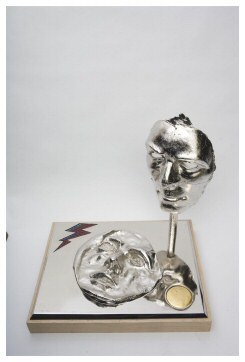
|
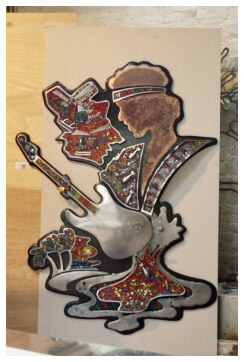
|
|
|
|
David
Bowie
|
Jimi
Hendrix
|
|
|
|
|
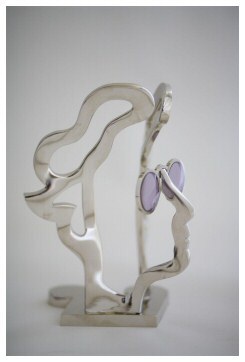
|
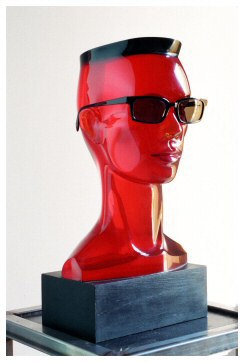
|
|
|
|
John
Lennon
|
Grace
Jones |
|
|
|
|
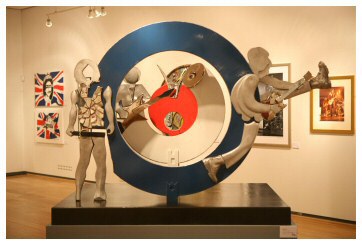
The
Who
|
|
|
|
|
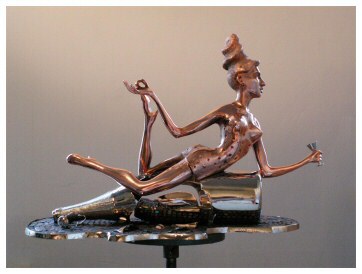
Amy
Winehouse |
Digger:
I was talking to someone the other day who's been on Dragon's Den
and she said that they didn't actually buy into what she was doing
but she wasn't expecting that. She was there for a good fifteen
minute promotion which it was. What were your expectations when you
went into the Den?
Guy:
I think my theory is that if you go in there and you fail, as an
artist , you have a big setback. I wasn't doing it from a point of
weakness because I was already a reasonably established sculptor and
I was exhibiting in some of the top galleries in London.
Digger:
Were the Dragons aware of you?
Guy:
Deborah Meaden was. She recognised the galleries that I quoted and
she asked me who represented me. She knew that I was at the good
galleries. And this is the measure of where you are. If I meet an
artist on the train who I don't know and I say "Who represents
you and which gallery are you with?" I can gauge where they are
on the league table just by that. Well the Albermarle are good and
they're top of the first division, but if you tell me White Cube
then I know you're really up there. I was already on that scale and
had I walked away completely shot down in flames my galleries would
have walked away from me as well because they would have said to me
"Look Guy, you took a risk, put your reputation on the line,
got shot down and we can't back you anymore."
Digger:
Tough, in that it's only five people's opinions - granted these are
astute business people who have been successful at what they do, but
theirs is a financial decision at the end of the day, isn't it?
Guy:
You have to remember that the whole art world at the highest level
is probably orchestrated by 50 people in the whole world. These are
the big hitters. The top of the pile is Gagosian and he's the God in
the art world and if he signs you up your work will go from being
worth £10 to £10,000 overnight. He commands that much influence.
And it come down from there but there are very few people that
control the market so you need to get one of those people on your
side. Or you've got to box clever really.
Digger:
What's the top seller of the icon Artworks?
Guy:
Top seller in terms of price or most popular?
Digger:
Most popular.
Guy:
The little John Lennon head, we have sold 10 of those in black and
now we're doing silver.
Digger:
Is the work selling the world over?
Guy:
It seems to connect with people on all levels the John Lennon. A) as
a piece of sculpture, because it's something you can have as a desk
piece or in a domestic situation. B) it's got a certain amount of humour
that people like and C) it's also an Icon who is popular with my potential
clientele. Sort of 40-60 year-old men. They're my sort of catchment.
(Digger laughs) I mean I very rarely sell these pieces to
women, although it does happen on the odd occasion. So they're the
ones with the money, the high earners and they want to buy into this
and they're revisiting their youth as well and so if you can connect
with all of those elements then you've got a sale. I have been at
art events enough to see the trends and it's rather amusing. Your
top seller is going to be the naked female form.
Digger:
Yes, I've got a couple of naked ladies in my house in deco
figurines.
Guy:
You will never sell a naked male. You'd sell 50 females to one male.
And then you move onto horses which is probably the next big thing.
Horses, eagles, dogs and cats. The funny thing with dogs and cats is
that people who buy dogs will only buy the dog they own. If they own
a Labrador they won't buy a spaniel. But if it's a cat you can sell
a cat to anybody who loves cats whether it's a Siamese or whatever.
So you're more likely to sell a cat because the chances of you
making a Labrador and a Labrador client coming along is minimal.
Digger:
This is crucial stuff isn't it?
Guy:
Yes, if you're running a business you've got to learn about your
marketing.
Digger:
Did you apply the same sort of rationale when you decided who the
subjects of these Icon Artworks were going to be? There's a good cross-section
there.
Guy:
I tend to look at the same thing from three angles. I put the idea
in the middle of the floor and I walk around it and I look at it
from one angle which is does it inspire me? The I walk round the
other side and I say can I afford to make it? And then I walk round
the other side and say will it sell and who will but it? If all the
answers are yes then I make it. And if one of the answers is no then
I think about it.
Digger:
What didn't make it ?
Guy:
I wanted to do The Clash - they were high up on my list, but the Sex
Pistols became such a strong piece visually and there was so much to
tap into with the Sex Pistols, so theatrical, that it was almost
doubling up and there would have been too much strength at that
point. When I came out of The Dragons' Den and I had to think where
do I start with this project and where do I finish it? I started
with Frank Sinatra because people didn't expect me to start with
Frank Sinatra and it actually grabbed their attention. Because they
think "Why?" And the answer is he was the first truly
global superstar in the age of television and radio after the war
years. And also he's highly respected by people like Bono and Elvis
Presley and Michael Jackson - he is respected by everybody. So he's
a powerhouse. And then I found a really good angle on the sculpture
with the Mafia influence and the Las Vegas influence. That was a
good start and then you think where am I going to finish and really
Amy Winehouse was the choice for the finishing because she went full
circle. Her work is almost Frank Sinatra - it's got some of the same
lyrical flow as some of the Frank Sinatra songs, it embraces soul,
blues and jazz. So in a way it covered the whole six decades, plus
visually she is very exciting to look at so that top and tailed
nicely. The problem that I had was that the 60s and 70s were so
strong and the 80s were weak comparatively so that you could
have done a whole exhibition virtually between '65 and '75 and it
was a case of who do you leave out? I left out The Rolling Stones, I
left out The Clash. We put Michael Jackson in in the end because we
had an angle on him when he died. We left out Elvis Presley. I left
out people who were almost caricatures of themselves.
Digger:
Jim Morrison?
Guy:
Jim Morrison was on my list and I researched and researched him and
I think if I did a second chapter then he would definitely make the
second cut. But it was that period which was so rich and I wanted to
spread it and I wanted three pieces from each decade. That was
roughly my aim. The 90s I struggled with - we ended-up with Tupac
and The Spice Girls. Because the people who made it big in the
sixties were still going and filling the stadiums.
Digger:
A lot of the acts that made it big in the 70s did their groundwork
in the 60s.
Guy:
Yeah, that's when they learned the trade and reinvented the whole
look. What was interesting for me was watching this movement which
started off in America - Frank Sinatra, Miles Davis, John Lee Hooker
and then we came over to London in the mid to late sixties and
London took the crown. And then I wanted to go back and get more of
a balance between the UK and America later in time with Madonna and
so on. And also some of the world influence with Bob Marley and
Grace Jones - world music tapping-in there as well. Then the Spice
Girls changed the way music was marketed and I wanted to reflect
that - they were a packaged band and the marketing people realised
that the big music buyers were 14 year-old girls and they started to
pitch everything towards them and that is still to some degree the
case today. And I wanted to illustrate that change of dynamic and by
putting them in a sweetie bag and making them out of sweets was a
tongue-in-cheek snipe at them as well. So it's piece of artwork
about them and is also about the packaging and marketing.
Digger:
What about - two things really, copyright on an image of a person.
Is there such a thing? And do you get feedback from these stars who
are still alive to tell you what they think?
Guy:
When the BBC got involved they were pretty cautious about what we
could and couldn't do so I had to go to some of the top legal minds
in the world on the subject.
Digger:
That sounds expensive.
Guy:
In fact it wasn't because they all pretty much gave me their advice
free. I don't know why, I suppose it was because it was so out of
the ordinary.
Digger:
And also by the time they'd said it, they'd said it.
Guy:
Yeah, when you're on the 'phone to them they are fascinated by the
project and they give you their answer. I did send some images and
they came back to me and said that will work and be fine. The only reservation
is probably California where the laws are different. But I had a
very funny story regarding the first solicitor I spoke to who said
"In England, you can legally make a sculpture of anybody and
there's no copyright on a person's face. In America, you can make one
of anybody but you can't make more than one and sell it. But there
is one proviso - Elvis Presley. He has certain limitations as to
what you can do." So I went to see my hairdresser before I went
on The Dragons' Den and I was telling him about this and before I
mentioned his name he said "Elvis Presley" and I said
"How did you know that?" and he said "My sister owns
the rights to Elvis Presley."
Digger:
Lucky.
Guy:
She owns the rights to Elvis and to Che Guevara in the UK but I
still didn't do it even though I had the contacts. In a way because
when people said "Do Elvis Presley" and I thought of
making him out of hamburgers. But all I'd do is upset Elvis Presley
fans and I wouldn't sell any sculptures. It would be a statement and
not please anybody. What I want to do is make a statement but not
offend.
Digger: You
want to provoke into thinking.
Guy:
I don't want to upset Presley fans. It doesn't do them or me any
good.
Digger:
So people like Bono and The Spice Girls are happy, are they?
Guy:
Nobody has complained. Which is the usual yardstick. I'm not quite
sure how I'd take it if someone like Grace Jones came along and said
"I don't want you to do that." I'd have to assess whether
or not their opinion would override my opinion. I would certainly
think about it and withdraw it if I thought it hadn't worked.
Digger:
You're right about art and music being inextricably linked. There's
a very close relationship.
Guy:
If you look at art as a bigger thing. We tend to look at art as a
sculpture or a painting on the wall. But art is fashion, jewellery,
photography. So when you start to look at it as a bigger chapter.
Then Grace Jones would not be the same without Jean Paul Gaultier
and the photographers or the set-designers, architects or make-up
artists. And whenever I give my lectures on art the first thing I
try to do with people is say "Try to think of 30 ways that art
influences the world. Car design... everything."
Digger:
Icons like the tube map or the red telephone box.
Guy:
You're right. As influential as the Mona Lisa. If not more so,
because it's more relevant. It's a great shame that we don't raise
the profile of all these people doing such great work, whether it be
designing a chair ... there's no less artistic merit in that than a
piece of sculpture.
Digger: What
have you got planned for the future, generally and also with regard
to the Icon Artworks?
Guy:
Well, now we've got the collection finished as a package we're
taking it on tour, and we've got about five or six things lined-up
between now and January 2010. We're in Birmingham next month, a
couple of small shows in London, we're doing Coldplay at Wembley in
two or three weeks time. Then we're having a big London show in
January. But we're close to doing a deal with three exhibitions in
China which will happen next year. It's a new market and they're
interested in western culture.
Digger:
How genned-up are they?
Guy:
That I really don't know. I was approached by an agent who said
"This will go down well in Asia." And we've built-up a
good working relationship, and to some degree I have to trust his instincts.
And I'll start asking around which stars are big in China.
Digger:
Might be some surprises there?
Guy:
Yes, I think so. Some stars may have gone under the radar. Maybe
they just get the Rolling Stones and The Beatles but not The Clash
and The Sex Pistols. There might be just the top of the pyramid so
that some pieces won't work for them because they are not getting
them and they don't know the background. That's what we need to look
at.
Digger:
This all sounds very exciting.
Guy:
It has been. We've spent the whole year doing this collection after
34 years of trying to move it forward, because I started it at 17 at
college and it's taken me until now just to find how to open that
door to get it onto the larger stage.
Digger:
Tenacity from you and inspiration from your daughter.
Guy:
Yes, I think I've learned a lot over the years and sometimes you're not
ready for an opportunity but now seemed about the right time.
Ten years ago I probably wouldn't have had the knowledge and in ten
years' time I probably won't have the energy. You learn out of
necessity and I think that's human nature and I certainly could not
have achieved what we have now ten years ago - bronze casting and
plating stuff. The knowledge that I have now and the back-up team I have
now - we have put a huge project together very quickly and this
wouldn't have been possible even ten years ago. We're still using
the same techniques that the Chinese were using 4,000 years ago but
it's on the bronze casting and electro-plating that have taken me a
long time to catch-up and get up-to-speed with it. Because I left
industry at 23 I've had to learn everything for myself. I spent some
time at the BBC doing special effects and had I stayed there I
wouldn't have developed that instinct for survival.
Digger:
What programmes were you working on?
Guy:
Blake's Seven, Dr Who.
Digger:
Wonderful, what a pedigree!
Guy:
Yes, the good thing there was that I was working alongside 30 other
specialists and I could dip in and out and see what they were doing
and just absorb all that knowledge and it was a great launch pad but
in a way it was a very comfortable life. And if I'd stayed there
longer I would never have left. You've just got to sometimes go the
hard route in order for you to reach your destination. It
has been a hard route but an enjoyable and fruitful one.
Digger:
Guy, it's been great talking to you. And the very best of luck with
the exhibitions, the tour and the continuing projects.
Guy:
Thanks David.
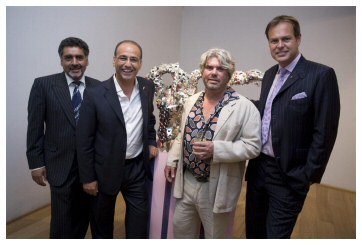
Guy with the Dragons
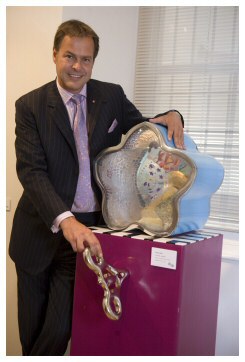
Dragon
Peter Jones with the Elton John sculpture
Guy Portelli interview. 26th August 2009.
More information at:
Guy's
Dragon's Den appearance on Youtube
Portelli
Pop Icon website
This page layout and content is the intellectual property of www.retrosellers.com
and cannot be reproduced without express permission.
We are not responsible for the content of external websites.
If we have inadvertently used any image
on this web site which is in copyright and for which we, or our
retailers on our behalf, do not have permission for use, please
contact us so that we can rectify the situation immediately. Images in
this article are, to the best of our knowledge, either in the public
domain or copyrighted where indicated.